
Hypericum calycinum is a species of prostrate or low-growing shrub in the flowering plant family Hypericaceae. It is native to the Strandzha Mountains along the Bulgarian and Turkish Black Sea coast. Widely cultivated for its large yellow flowers, its names as a garden plant include rose-of-Sharon in Britain and Australia, and Aaron's beard, great St-John's wort, creeping St. John's wort and Jerusalem star.
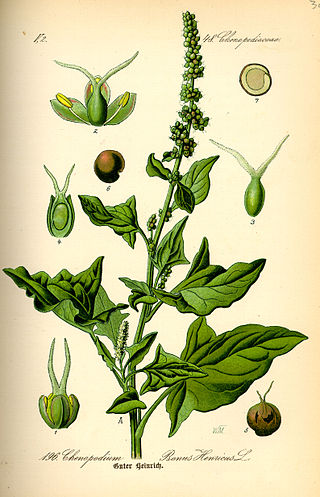
Blitum bonus-henricus, also called Good-King-Henry, poor-man's asparagus, perennial goosefoot, Lincolnshire spinach, Markery, English mercury, or mercury goosefoot, is a species of goosefoot which is native to much of central and southern Europe.

Dysphania ambrosioides, formerly Chenopodium ambrosioides, known as epazote, Jesuit's tea, Mexican tea or wormseed, is an annual or short-lived perennial herb native to the Americas.

Lycopodium clavatum is the most widespread species in the genus Lycopodium in the clubmoss family.

Andromeda polifolia, common name bog-rosemary, is a species of flowering plant in the heath family Ericaceae, native to northern parts of the Northern Hemisphere. It is the only member of the genus Andromeda, and is only found in bogs in cold peat-accumulating areas. Andromeda glaucophylla is a synonym of A. polifolia var. latifolia.
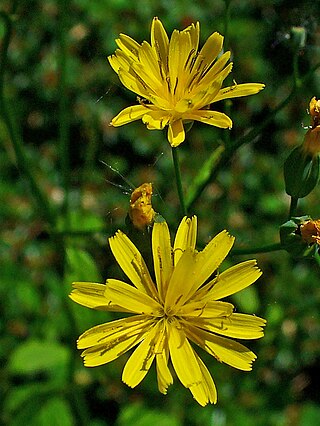
Lapsana communis, the common nipplewort, is a species of flowering plant in the family Asteraceae. It is native to Europe and southwestern Asia, and it is widely naturalized in other regions including North America.

Scheuchzeria palustris, is a flowering plant in the family Scheuchzeriaceae, in which there is only one species and Scheuchzeria is the only genus. In the APG II system it is placed in the order Alismatales of the monocots.

Caucalis platycarpos is a species of flowering plant in the family Apiaceae, the only member of the genus Caucalis. Common names are carrot bur parsley, small bur-parsley, and burr parsley. It is native to Europe, North Africa, and the Middle East as far east as Iran.
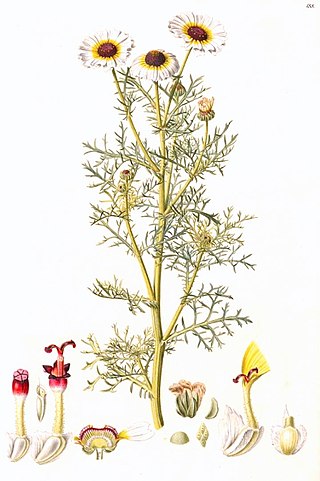
Ismelia carinata, the tricolour chrysanthemum, tricolor daisy, or annual chrysanthemum, is an ornamental plant native to north Africa that is cultivated as a garden plant and grows as a weed in California. It is the sole species in the genus Ismelia. It has been hybridized with related Argyranthemum species to create cultivars of garden marguerites.
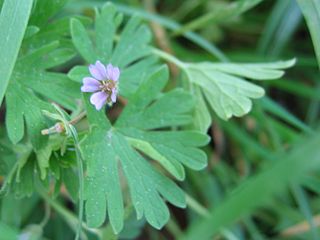
Geranium pusillum, commonly known as small-flowered crane's-bill or small geranium, is a herbaceous annual plant of the genus Geranium.
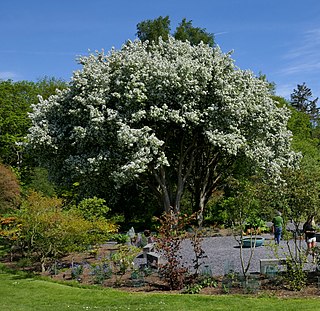
Malus hupehensis, common names Chinese crab apple, Hupeh crab or tea crabapple, is a species of flowering plant in the apple genus Malus of the family Rosaceae.

Utricularia intermedia, the flatleaf bladderwort or intermediate bladderwort is a small, perennial carnivorous plant that belongs to the genus Utricularia. It is usually found affixed to the substrate but it can also survive suspended in a body of water. U. intermedia is a circumboreal species and is found in North America, Asia, and Europe.

Glyceria maxima, imfe Nd commonly known as great manna grass, reed mannagrass, reed sweet-grass, and greater sweet-grass is a species of rhizomatous perennial grasses in the mannagrass genus native to Europe and Western Siberia and growing in wet areas such as riverbanks and ponds. It is highly competitive and invasive and is often considered to be a noxious weed outside its native range.
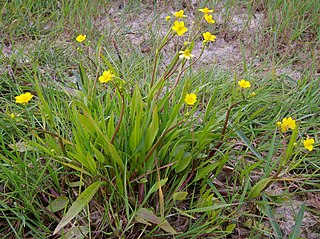
Ranunculus flammula, the lesser spearwort, greater creeping spearwort or banewort, is a species of perennial herbaceous plants in the genus Ranunculus (buttercup), growing in damp places throughout the Boreal Kingdom. It flowers June/July. Ranunculus flammula is poisonous. It is very closely related to R. reptans, which is distinguished by prostrate and more slender stems, narrower leaves and smaller flowers and is sometimes included within R. flammula sensu lato as a variety.

Trypeta immaculata is a species of tephritid or fruit flies in the genus Trypeta of the family Tephritidae.

Aetheorhiza is a genus of flowering plants in the daisy family described as a genus in 1827.

Geropogon is a genus of flowering plants in the family Asteraceae.
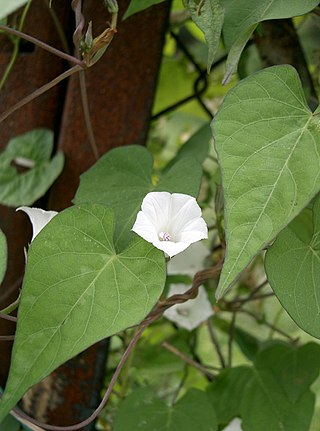
Ipomoea lacunosa, the whitestar, white morning-glory or pitted morning-glory, is a species that belongs to the genus Ipomoea. In this genus most members are commonly referred to as "morning glories". The name for the genus, Ipomoea, has roots in the Greek words ips and homoios, which translates to worm-like. This is a reference to the plant's vine-like growth. Lacunosa comes from a Latin word meaning air spaces, correlating with the venation of the leaves. Ipomoea lacunosa is native to the United States and grows annually. The flowers of this species are usually white and smaller than most other morning glories.

Iris tuberosa is a species of tuberous flowering plant of the genus Iris, with the common names snake's-head, snake's-head iris, widow iris, black iris, or velvet flower-de-luce.



















